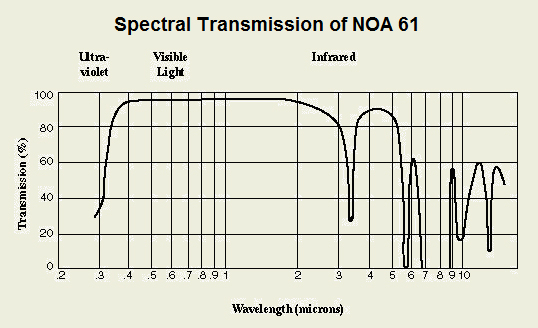- Home
- UV cured adhesives
- Acrylates
- Norland UV adhesives
- Optical adhesives
- Norland NOA 61
Norland NOA 61
Norland Optical Adhesive 61 (NOA 61) is a clear, colorless, liquid photopolymer that will cure when exposed to ultraviolet light. Since, it is a one part system and 100% solid, it offers many advantages in bonding where the adhesive can be exposed to UV light. The use of NOA 61 eliminates premixing, drying or heat curing operations common to other adhesive systems. Curing time is remarkably fast, and is dependent upon the thickness applied and the amount of ultraviolet light energy available.
NOA 61 meets Federal Specification MIL-A-3920 for optical adhesives, and is approved for use on all government contracts specifying such adhesives. The adhesive is designed to give the best possible optical bond to glass surfaces, metals, fiberglass and glass filled plastics. NOA61 is recommended for bonding lenses, prisms and mirrors for military, aerospace and commercial optics as well as for terminating and splicing optical fibers.
NOA 61 also has excellent clarity, low shrinkage and as light flexibility that make it superior to other materials for optical bonding. These characteristics are important in order for the user to produce high quality optics and achieve long term performance under changing environments.
NOA 61 is cured by ultraviolet light with maximum absorption within the range of 350-380 nanometers. The recommended energy required for full cure is 3 Joules/sq. cm in these wavelengths. The cure is not inhibited by oxygen, hence any areas in contact with air will cure to a non-tacky state when exposed to ultraviolet light.
In most optical applications, curing is done in two steps. A short, uniform exposure, or precure, is used first. The precure time is of sufficient duration to set the bond and allow it to be moved without disturbing alignment. This is followed by a longer cure under UV light to obtain full crosslinking and solvent resistance of the adhesive. The precure can be obtained in 10 seconds using a 100 watt mercury lamp at 6″. Where longer time is required for alignment, it can be extended to a few minutes using a very low intensity light source. The final cure can be accomplished in 5 to 10 minutes using the 100 watt mercury lamp.
The precure allows the user to align and set the precision parts quickly, and minimizes the number of holding fixtures required. After the precure, excess adhesive can be wiped up with an alcohol or acetone moistened cloth. Assemblies should be inspected at this time and rejects separated in methylene chloride. The bonded area must be soaked in the solvent and normally will separate overnight. The time required to break the bond depends upon the extent of the cure and the size of the bond area.
When fully cured, NOA 61 has very good adhesion and solvent resistance, but it has not reached its optimum adhesion to glass. This will come with aging over a period of about 1 week in which a chemical bond will form between the glass and adhesive. This optimum adhesion can also be obtained by aging at 50° C for 12 hours.
NOA 61 can withstand temperatures before aging from -15°C to 60° C when used for glass bonding. After aging, it will withstand temperatures from -150° C to 125° C.

Shelf life of liquid is at least 4 months from the date of shipment if stored in a cool (5-22° C), dark place in the original container. If refrigerated, allow the adhesive to come to room temperature prior to use.
Care should be taken in handling this material. The Material Safety Data Sheet (MSDS) should be read for this product as well as forany associated products such as alcohol, acetone or methylene chloride. Prolonged contact with skin should be avoided and affected areas should be thoroughly washed with copious amounts of soap and water. If the adhesive gets into eyes, flush with water for 15 minutes as seek medical attention. Use the material in a well ventilated area, otherwise a NIOSH approved organic vapor mask is recommended.

